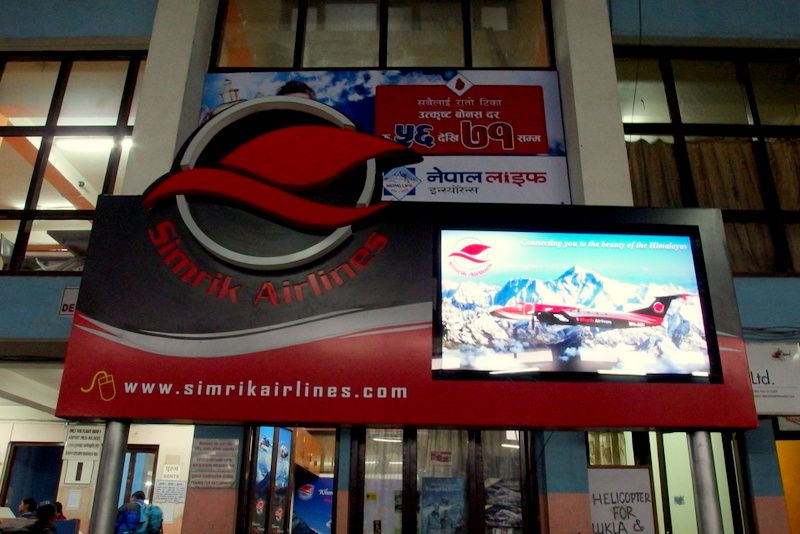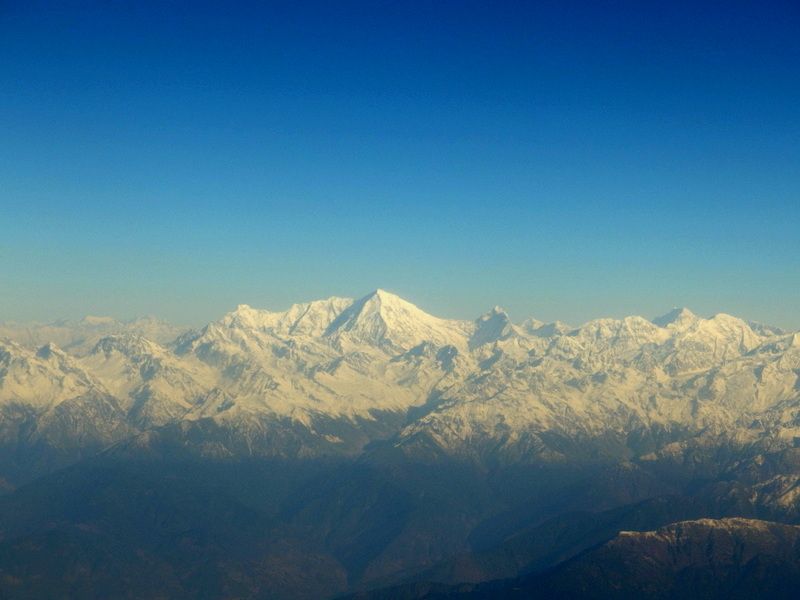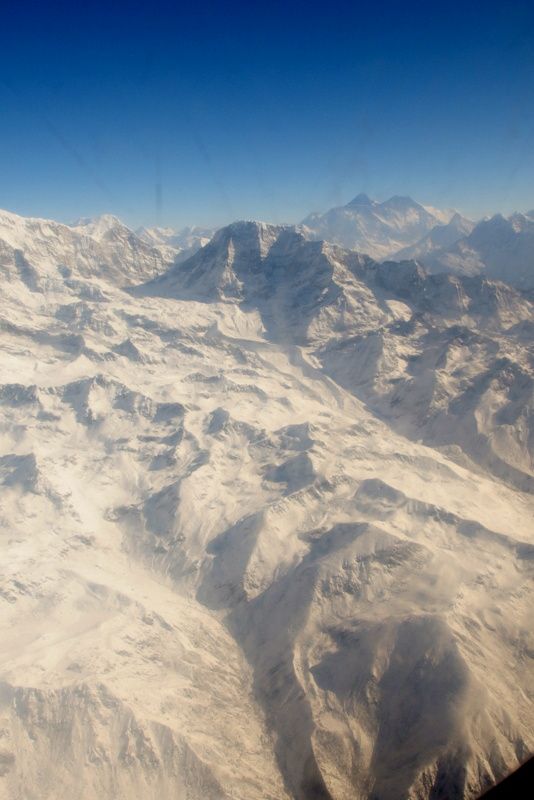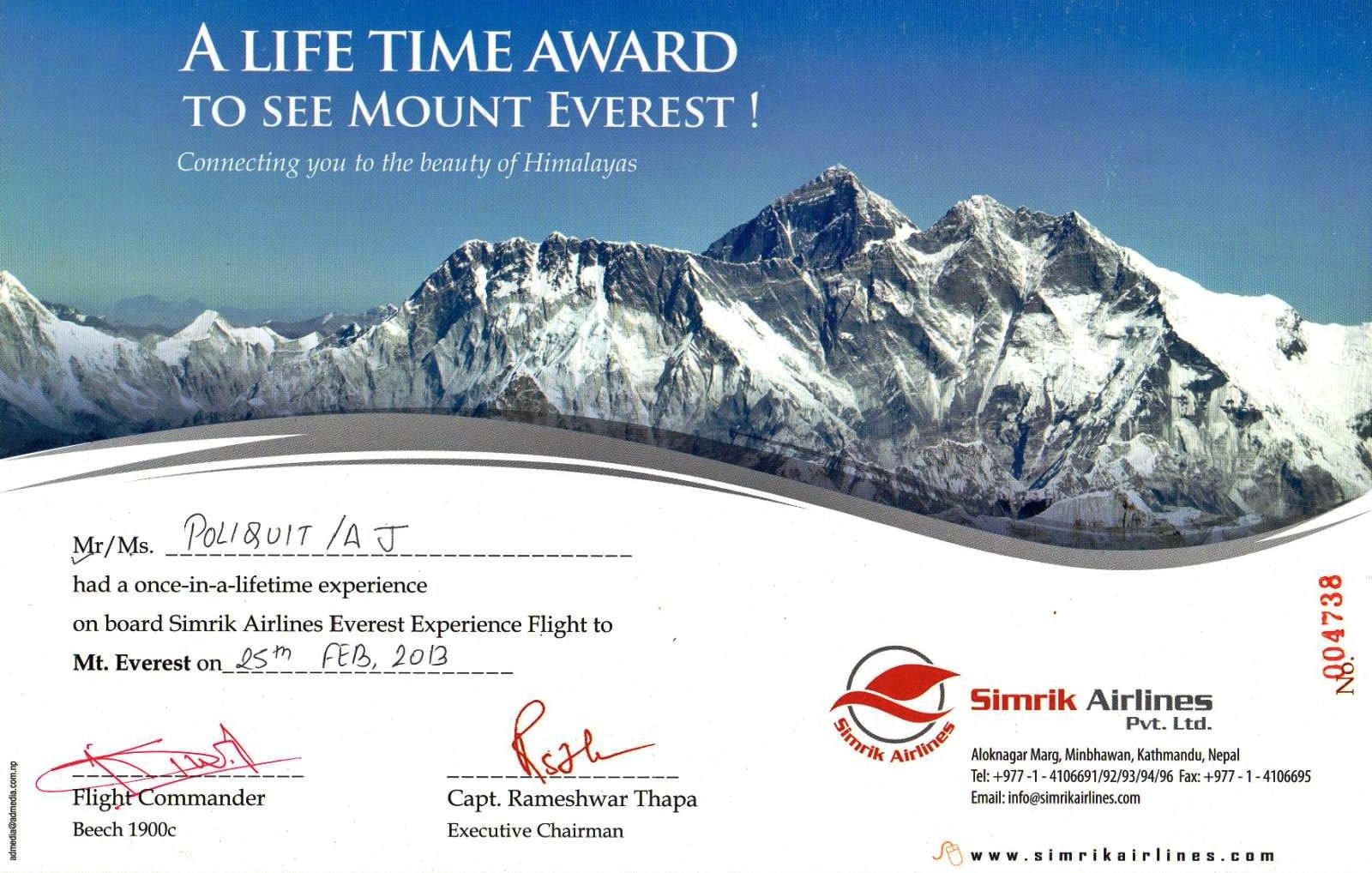Kathmandu, Nepal
February 24 – 25, 2013
“Why Nepal?” I had been asked too many times before my trip. I would give a terse reply, “Everest,” name-dropping the world’s highest mountain in the hopes of eliciting at least a streak of recognition on people’s faces. Instead, I was met with quizzical looks. Even at the Air Asia check-in counter at Kuala Lumpur, the airport staff confirmed my destination by asking, “Are you sure?” I wondered if I should’ve taken it as a last-minute escape clause.
Random people’s incredulity about the travel worthiness of the country or, more likely, my level of physical fitness to see the world’s highest peaks only deepened my resolve. Really, why not Nepal? It was no small blessing, then, finding two kindred spirits, my travel buddies Ayee and Donna, who did not bat an eyelash when I offhandedly suggested traveling there.




Our minds were set on just one track, and it led to the roof of the world. None the outdoorsy type, we neither had the hardy constitution (hence, the “Why Nepal?” queries) nor the time to trek even the lower reaches of the Himalayas. Craning our necks to see beyond the foothills wouldn’t do.
The next best thing was a mountain flight. Though it set us back about $100 each, a discounted tour package by Hotel Buddha Land manager Bhanu Dhakal, for just an hour’s spectacle, it was a non-negotiable item in our itinerary. Wimpy connotations aside, the flight required a degree of reckless abandon to fly over barren mountains beaten by treacherous winds on a small plane.
The 19-seater Beechcraft operated by Simrik Airlines positioned for takeoff from Tribhuvan International Airport at 7:30 AM. The propellers vroomed several times, yet the plane remained on the runway. The weather, we were told, was not particularly cooperative that morning. True, the sky was overcast, not a hint of blue on the opaque curtain of white, seizing every bit of frail sunshine that pierced through.


The Spanish couple before me was getting antsy. The woman implored me to explain, with “little English only,” the cause for the delay, which I relayed in a telegraphic summary: “Weather no good, mountain no see, plane no fly.” The plane taxied back to the terminal where we waited half an hour more for the skies to clear. “Trienta minutos esperar,” I translated the announcement in survival Spanish. They grinned, their faces illuminated by comprehension.
Alas, the frigid air soon condensed into water droplets. The flight was called off to the next morning, weather permitting. The Himalayas were known to do a Garbo. At midday, the mountains shyly retreated behind a cloak of clouds. Only a narrow time window early in the morning would grant – reluctantly, I might add – a glorious peek at the lofty peaks. I felt equal parts disappointment and relief. While I was itching for an Everest sighting, I appreciated the airline company’s policy of not compromising both our safety and a clear mountain view.
There was wisdom in taking this mountain flight early on in our stay in Nepal. It allowed elbow room for the weather’s unpredictability without it overhauling our tight schedule. Fingers crossed, there was still “tomorrow.”


The next day, the sun burst out, bathing the mountains in a warm glow. At 8 AM, the Beechcraft flew out of Kathmandu. Within minutes, we were hovering over the corrugated terrain of the Himalayas. A scale drawing was provided with which to identify the mountains by name and height, although the sole flight attendant worked the aisle to give a running commentary.
On the ascent, the foothills crowned by flimsy tufts of snow came into view. As we reached cruising altitude, the snow line dropped and the mountain range turned into a glistening mantle of white. Despite sharing latitudes with Egyptian deserts and Florida swamps, the Himalayas, Sanskrit for “abode of snow,” were perpetually snow-capped.



The flight covered the Nepal side of two Himalayan segments, Rowaling Himal, containing the sacred mountain Gauri Shankar, and Mahalangur Himal, boasting four of the ten highest mountains in the world:
1st – Everest (Sagarmatha in Nepali) at 29,029 feet (8,848 meters)
4th – Lhotse at 27,940 feet (8,516 meters)
5th – Makalu at 27,825 feet (8,481 meters)
6th – Cho Oyo at 26,906 feet (8,201 meters)
The peaks belonged to an elite club – only 14 in the world – called “the eight-thousanders,” their summits pushing up beyond 26,000 feet (8,000 meters) above sea level – death zone to mountaineers. Oxygen levels, not to mention unpredictable weather changes, at this altitude could barely sustain human life.
I hoped for a closer approach, but the plane kept a safe distance from steep cliffs and plunging crevasses. There was not much room for such details in an abridged view of the world’s fifth longest mountain range.


Rolling by the oval airplane window, the Himalayan mountains jostled for the sky. Mount Everest was unmistakable in this honor roll of peaks, its pyramidal summit jutting out of the jagged Nuptse massif.
I pressed my face and camera lens against the Plexiglas to take in the height and breadth of the Himalayas – to no avail, of course. The horizon could not even contain this magnificent wall of snow and rock, the crumpled evidence of invisible tectonic movement. The mountains, geologically young, were still growing as the Indian subcontinent obstinately pushed its way into continental Asia.
The mountains pushed their way inward as well – into the beholder. The majestic sight was less thrilling than it was touching, strange and distant as these mountains were to me. The Spanish couple sealed their Everest experience with a kiss. I teared up, intoning the names of my loved ones in a vain attempt to share this once-in-a-lifetime milestone. What had I done to merit such an experience?

To compensate for the pin-eye view from the fuselage, the tour offered a treat: passengers were individually summoned forward for an unobstructed panorama. Crouching in the cramped cockpit, I was rendered linguistically-challenged by the full-on expanse of the Himalayas before me. My vocabulary was reduced to one word, “uh-mazing,” until I broke into song – The Carpenters’ Top of the World, predictably.
I was last to be called. Still, the pilot pointed out the peaks enthusiastically, not because it was his first time, but because it was mine. His co-pilot was not as affable. Annoyed, he flicked my dangling camera lanyard away from the cockpit controls – for good reason. As the first officer, he focused on flying the plane while the captain played airborne tour guide.
Everest and its comparatively flat-topped neighbor Lhotse, fourth highest in the world, appeared inseparable with a ridge around each other like the partners in crime that they were; both had claimed the lives of countless mountaineers.
Makalu, the fifth highest, slid into the cockpit’s cinemascope frame at the far right, mirroring the conical Everest summit. The wind-battered and glacier-sculpted rocky desolation looked surreal and spine-tingling: the ghosts of geologic past, veiled in an eerie blanket of white.


We flew past all the peaks in our flight path twice, as the plane made a U-turn upon reaching Everest. Gauri Shankar, a Hindu sacred mountain, was lovelier the second time around. Its pair of sharp peaks, Gauri and Shankar, the goddess wife of Shiva and Shiva himself, respectively, was clearly delineated.
In fact, Hindus viewed the entire range as the home of gods, each mountain a pillar in this Hindu Pantheon. Many of its peaks, routinely “conquered” by the indomitable human spirit, were now littered with mountaineering remnants, including frozen corpses, and defiled by ambition and pride.
For the Nepali Hindu and Buddhist, these mountains remained sacred, comprising the collective soul of their gods, and revered as the source of life, its melted snow feeding the holy rivers that nurture the spirit and body of millions living in the valleys of Nepal and the plains of India.

The Himalayas, then, were akin to a place of worship. We approached the mountains with savoir-faire, maintaining a reverent distance that would not offend both gods and believers, when we had been allowed to have an audience with them. After all, storm clouds could easily gather to banish us from holy ground. The Himalayas may be the dwelling place of Hindu gods, but it was by God’s grace that I witnessed its grandeur in my lifetime. That was why Nepal.
Discouraging his son from following his footsteps to the top of the world, Tenzing Norgay, the Sherpa climber who became one of the first men to summit Everest, said, “I already climbed it for you. You don’t have to work on the mountain.”
So it was with God. He had climbed our mountains for us as an unmerited favor, not unlike that awe-inspiring experience of flying on a small plane in the finest weather above the Himalayas.



Thanks for reading! If you like my content, you may…





TTT is back online! I will dig new vocabularies once again.
At $160 its kinda steep, but considering the chance to see the peak of Everest and the other top 7 peaks of the world, its a chance one shouldn’t let go. Reminds me to save up additional $160 pocket money for Nepal.
Cross fingers hope to go there late this year or definitely early next year.
New vocab ka jan, che! 😀
To be honest, I’m not sure if we really shelled out $160 for it. That was the original quote, but the owner of Hotel Buddha Land gave us a package deal that included other tours and a guide on top of that mountain flight. I guess we got a discounted rate. I’m bad at numbers so my blog is not reliable when it comes to hard facts like that, haha!
How nice to finally catch a post about Nepal and Everest at TTT. I was, in fact, waiting for this one. I want to go to Nepal too considering the fact that it’s so close to India. Maybe sometime soon. Now that you’ve covered the flight journey, when are the other parts of the journey coming up as posts?
Looking forward.
Joy always,
Susan
So many stories to tell, so little time to write, Mrs Sus. Coming up next (can’t say when though, hehe): the living goddess of Patan.
As I always say, Nepal is not just a place; it’s an experience. Really, you should go see for yourself.
Namaste.
TTT
I have never wanted to see Mt. Everest nor Nepal. But after reading your blog I felt that I have actually gone there and seen it. And oh what an experience it was. Thank you so much for my risk-free and completely free experience.
Neither did I, but I fell in love with the country. Nepal is more than the sum of all the Himalayan peaks within its borders. I hope I could go back, not just as a tourist, but to give back to the Nepalis for the richness of experience and genuine hospitality they have shown me.
WORTH EVERY PENNY! Ahh, sooo drooling right now. Will wait for Luna to grow a bit older before we do such flight.
Oh, Luna, the globetrotting tot, can certainly do this. And when she’s even a bit older, you can take her hiking Himalayan trails, which I also plan to do, finances and fitness permitting. 🙂
After reading this, I felt like I traveled with you! It’s at the top of my list!
Hi Spydey! The top of the world deserves no less than the top of the list. 🙂
Next time, climb the mountain A.J. for God’s sake. That is an order! 🙂
I will but not the Himalayas. Mt Pinatubo will do, just like you. Daya mo, sana sinama mo ko. Huhuhuhu
I don’t think we spent $160 for the flight… i think we got a discount… i’ll have to double check my pictures. I still have our computations and receipts 😉
Hmmm mental note: take photos of receipts. My brain automatically rejects anything that involves numbers. 🙂 Good going Dons!
After reading your narratives, I’m totally considering this Everest Mountain Flight. I’ll be visiting this October 🙂
If you don’t have the time for trekking, this is the next most exhilarating way to see Everest and the Himalayas. Glad I’ve inspired another person to try this out. Enjoy Nepal, Shie!